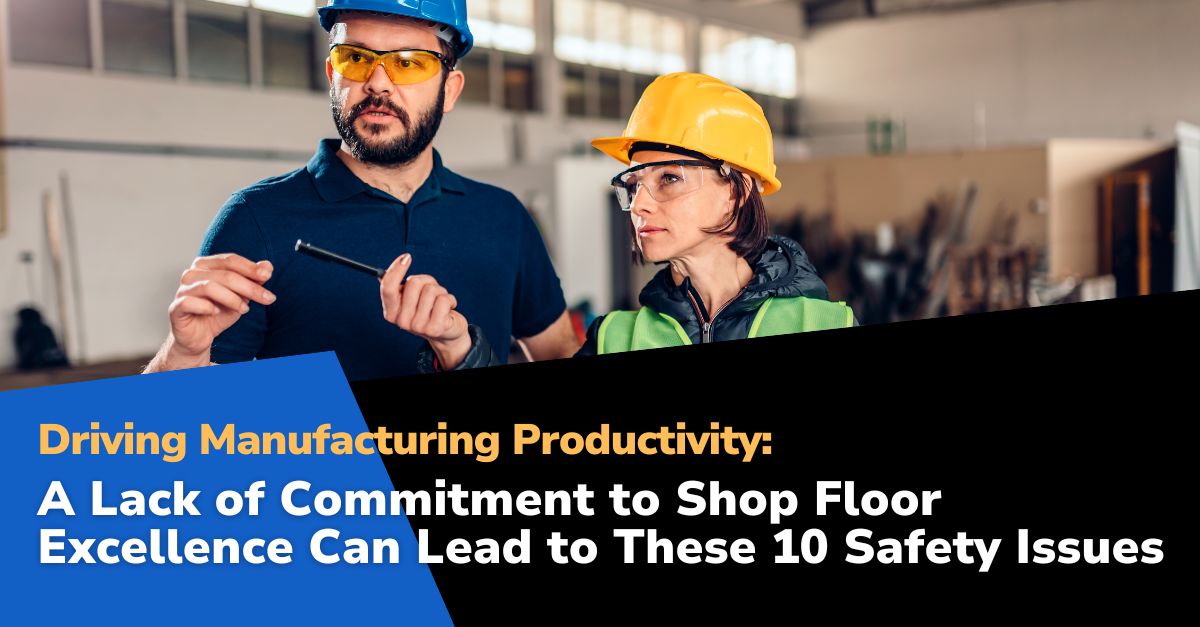
Safety in manufacturing is not just a compliance requirement; it’s a fundamental responsibility that has far-reaching implications for employees, productivity, and the company’s reputation.
The often-complex interplay of machinery, workflows, and human factors makes the manufacturing floor a place where safety must be an ingrained part of the culture, not just an afterthought. Ignoring it can have catastrophic consequences, ranging from minor injuries to major accidents, potentially leading to loss of life, legal ramifications, and significant financial losses.
In this critical fifth installment of our ten-part series, we delve deeply into the top 10 safety concerns that frequently emerge in manufacturing environments where Shop Floor Excellence (SFE) is not a priority. These concerns are not just isolated problems; they indicate systemic issues that can pervade the entire manufacturing process when SFE principles are overlooked.
More importantly, we explore how the proactive adoption of SFE principles can act as a powerful countermeasure, turning potential safety hazards into well-managed risks. By embedding SFE into the fabric of the manufacturing process, we can create environments that prioritize every employee’s well-being, enhance operational efficiency, and maintain the integrity of the production line.
1Increased Accident Rates:
In environments where safety checks are overlooked, incidents like machinery entanglement or slip-and-fall accidents due to unclean floors become common.
Solution: Develop a safety protocol that includes frequent hazard assessments, mandatory safety training with hands-on demonstrations, and strict adherence to a clean-as-you-go policy to prevent accidents.
2Equipment-Related Injuries:
Machinery without proper guarding or failing safety mechanisms can lead to severe injuries. For instance, an unguarded conveyor belt can easily catch an employee’s clothing or limbs.
Solution: Implement a rigorous equipment safety program, including regular safety audits, installation of necessary guards, and automatic shut-offs for machinery. Ensure that all employees are trained on emergency stop procedures
3Hazardous Material Incidents:
Mishandling of chemicals can cause dangerous spills or toxic exposures. For example, a chemical spill without proper containment measures can lead to respiratory issues and burns.
Solution: Create strict guidelines for handling hazardous materials, including spill containment protocols, proper ventilation systems, and mandatory use of PPE like gloves and respirators when handling these materials.
4Ergonomic Injuries:
Continuous work without ergonomic support, like prolonged standing or repetitive motions, can lead to chronic injuries such as tendonitis or lower back pain.
Solution: Conduct ergonomic assessments to redesign workstations. This can include adjustable height desks, ergonomic tools to reduce strain, and implementing micro-breaks for employees to prevent repetitive strain injuries.
5Fire and Electrical Hazards:
Faulty wiring or improperly stored flammable materials can lead to devastating fires or electrical shocks.
Solution: Regular electrical safety inspections, staff training on handling electrical equipment, and proper storage protocols for flammable materials. Also, ensure that fire extinguishers and emergency exits are easily accessible.
6Slips, Trips, and Falls:
A cluttered factory floor or improperly cleaned spills can result in slips or trips, among the most frequent causes of workplace injury.
Solution: Maintain stringent housekeeping standards, clear walkways, promptly address spills, and use signage for wet floor areas. Install railings or barriers in high-risk zones.
7Inadequate Emergency Response:
Lack of preparedness for emergencies like chemical spills, fires, or machinery failures can exacerbate situations, leading to injuries or even fatalities.
Solution: Develop a detailed emergency action plan, conduct regular emergency drills (fire, evacuation, spill response), and ensure all employees know their roles in an emergency.
8Poor Safety Communication:
Ineffective dissemination of safety information can leave employees unaware of potential risks or how to react in hazardous situations.
Solution: Implement regular safety briefings, clearly display safety procedures and hazard information throughout the workplace, and establish a system for reporting safety concerns.
9Lack of Personal Protective Equipment (PPE):
Failure to provide or enforce PPE can lead to avoidable injuries like chemical burns from not using gloves or hearing loss from not using ear protection.
Solution: Ensure easy access to the appropriate PPE for each job, provide training on its correct use, and strictly enforce PPE usage policies.
10Compliance Issues:
Failing to comply with safety regulations can lead to legal liabilities, financial penalties, and damage to the company’s reputation.
Solution: Regularly update safety protocols per industry regulations, conduct compliance audits, and learn to stay abreast of new safety standards and technologies.
Addressing these safety concerns through the lens of SFE enhances employees’ well-being and improves overall operational efficiency and compliance.
Elevating Safety with The POWERS Approach
At POWERS, safety is an integral component of manufacturing excellence. Our approach to incorporating SFE in safety management is designed to identify and mitigate risks, ensuring a safe and productive work environment.
Transform your approach to safety with POWERS.
Our team is ready to guide you through implementing effective SFE strategies, elevating your safety standards, and enhancing your operational performance.
Contact us at +1 678-971-4711 or info@thepowerscompany.com for a comprehensive solution that aligns your safety practices with the highest standards of Shop Floor Excellence. Let’s work together to build a safer, more productive future in manufacturing.
Continue Reading from this Mastery Series
- Part 1 - The Perils of Overlooking SFE in Assembly Line Setup
- Part 2 - A Lackluster Approach to Shop Floor Excellence Impacts Workforce Engagement
- Part 3 - The Consequences of Sidestepping Data-Driven Decisions in Shop Floor Excellence
- Part 4 - Without Shop Floor Excellence, Product Quality Can Drop Like a Rock
- Part 5 - A Lack of Commitment to Shop Floor Excellence Can Lead to These 10 Safety Issues
- Part 6 - Shop Floor Excellence Makes Your Operation More Agile, Flexible, and Adaptable to Market Changes
- Part 7 - Bridging the Gap with Effective Communication in Shop Floor Excellence
- Part 8 - How Ignoring Shop Floor Excellence Undermines Continuous Improvement
- Part 9 - Tackling Inefficient Energy and Material Use with Shop Floor Excellence
- Part 10 - Enhancing Customer Focus Through Shop Floor Excellence







